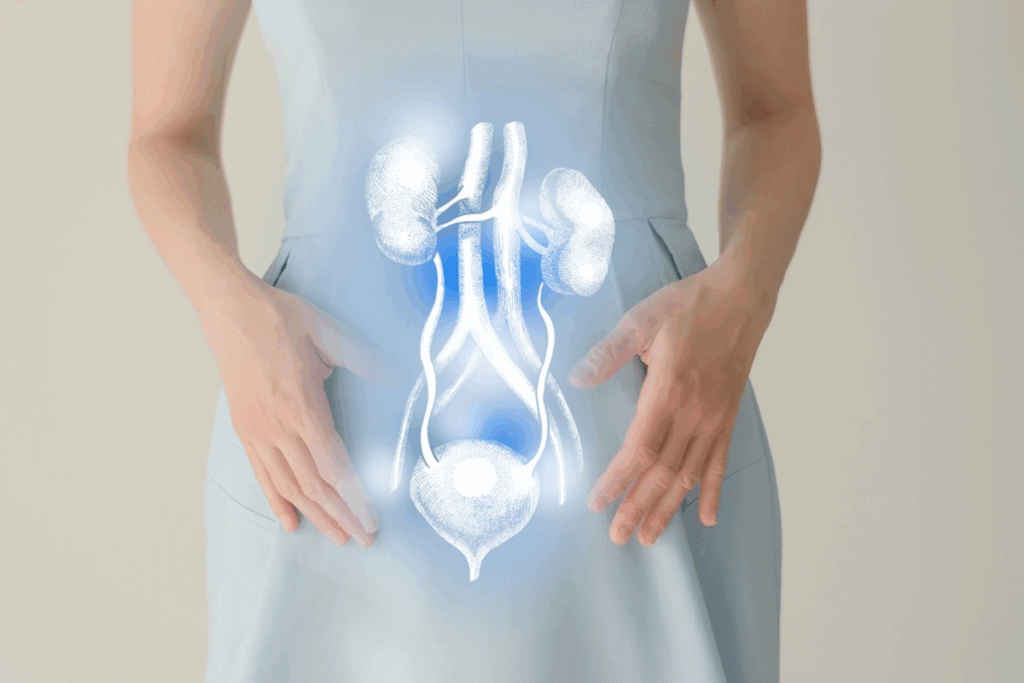Last Updated on November 25, 2025 by Ugurkan Demir

Seeing blood in your urine when you have a urinary tract infection can be scary. But, it’s actually a common symptom. This happens because the UTI inflammation irritates the lining of your urinary tract. This irritation makes red blood cells leak into your urine.
It’s important to understand why this happens and when to see a doctor. At Liv Hospital, we focus on you. We make sure you get the best care for your UTI symptoms.

UTIs are a common health issue that can affect anyone. They cause discomfort and can lead to serious complications if not treated quickly.
A Urinary Tract Infection (UTI) happens when bacteria get into the urinary tract. This includes the kidneys, bladder, and the tubes that connect them. Most UTIs happen in the lower urinary tract, like the bladder and urethra.
UTIs are mainly caused by Escherichia coli (E. coli) bacteria. These bacteria are common in the gut. Other causes include:
| Cause | Description | Risk Factor |
| Bacterial Entry | Bacteria entering through the urethra | Sexual activity |
| Sexual Activity | Increased risk during sexual intercourse | New sexual partners |
| Birth Control | Use of diaphragms or spermicides | Women using these methods |
While anyone can get a UTI, some are at higher risk. These include:
Knowing these risk factors helps prevent UTIs. It also means getting medical help quickly when needed.

UTIs can cause bleeding, but why does this happen? When bacteria infect the urinary tract, it leads to inflammation and irritation. This irritation makes red blood cells leak into the urine, known as hematuria. We’ll look into how UTIs cause bleeding and how common it is.
Bacteria in the urinary tract cause an infection. This infection makes the tract’s lining inflamed and irritated. This irritation makes the blood vessels in the tract weak, leading to blood in the urine.
Bacteria like Escherichia coli (E. coli) often cause UTIs. When these bacteria stick to the bladder or urethra walls, they can start an infection that leads to bleeding.
The urinary tract’s lining is very sensitive. When it gets infected, it becomes inflamed and irritated. This irritation can make the blood vessels burst, causing hematuria. The level of inflammation can vary, but it often leads to noticeable symptoms, including bleeding.
Research shows UTIs are a common cause of blood in urine. Studies reveal that a big percentage of patients with UTIs have some form of hematuria. About 20-30% of women with UTIs see blood in their urine, according to medical data.
It’s important to understand the link between UTIs and bleeding for proper treatment. If you’re bleeding with a UTI, seeing a healthcare provider is key to finding the right treatment.
It’s important to know about the different bleeding types linked to UTIs. This knowledge helps in diagnosing and treating the issue correctly. Each type of bleeding has its own meaning and implications.
Gross hematuria means you can see blood in your urine. It looks pink, red, or cola-colored. This is a clear sign to see a doctor. The blood is usually due to the infection irritating the urinary tract.
This symptom is serious and needs to be checked out. While it’s often linked to UTIs, finding the real cause is key.
Microscopic hematuria is when blood in urine is only seen with a microscope. It’s often found during a routine urine test.
This type of bleeding can mean a UTI, but it might also point to other issues. So, a detailed check is needed to find the cause.
It’s important to tell the difference between bloody discharge and blood in urine. Bloody discharge can happen in many genital or urinary tract problems. But blood in urine (hematuria) is more specific to the urinary system.
Knowing the difference helps doctors find and treat the right problem.
| Type of Bleeding | Description | Detection Method |
| Gross Hematuria | Visible blood in urine | Naked Eye |
| Microscopic Hematuria | Invisible blood in urine | Microscope |
| Bloody Discharge | Discharge with blood, not necessarily in urine | Visual Examination |
When a urinary tract infection (UTI) leads to bleeding, it’s often accompanied by other uncomfortable symptoms. Understanding these symptoms can help patients seek appropriate medical care.
Pain or burning during urination, also known as dysuria, is a common symptom. This discomfort occurs due to inflammation and irritation of the urinary tract lining. The presence of blood can make it worse.
Patients often describe this sensation as a sharp burning or stinging feeling. This feeling can be mild or severe. The pain may be constant or only occur during urination.
UTIs that cause bleeding often lead to increased frequency and urgency in urination. Patients may find themselves needing to urinate more often than usual. They may also have a strong, sudden urge to do so.
This frequency and urgency can disrupt daily activities and sleep patterns. Some patients may feel like their bladder is not fully emptying. This can add to the discomfort.
In addition to pain, burning, frequency, and urgency, other symptoms may accompany UTI bleeding. These can include:
It’s essential to recognize these symptoms and seek medical attention if they occur. Untreated UTIs can lead to more severe complications.
The following table summarizes the common symptoms that may accompany UTI bleeding:
| Symptom | Description |
| Pain/Burning During Urination | Sharp burning or stinging sensation during urination due to inflammation and irritation. |
| Frequency and Urgency | Increased need to urinate, often with a sudden, strong urge, disrupting daily activities. |
| Cloudy/Strong-Smelling Urine | Urine may appear cloudy or have an unusually strong odor, indicating infection. |
| Pelvic/Lower Abdominal Pain | Discomfort or pain in the pelvic or lower abdominal region, associated with the infection. |
The location of a UTI in the urinary tract affects bleeding patterns. Knowing these differences helps in diagnosing and treating UTIs.
Bladder infections, or cystitis, are common UTIs. Bleeding from cystitis can show as hematuria, or blood in the urine. This can be tiny or change the urine’s color.
The inflammation from cystitis can irritate the bladder lining, leading to bleeding. The bleeding’s severity varies but is usually mild.
Kidney infections, or pyelonephritis, are more serious UTIs. They can cause significant bleeding. The infection can damage kidney tissues, leading to more noticeable hematuria.
In severe cases, kidney infection bleeding can be heavy. It may also cause flank pain and fever. If symptoms get worse, seek medical help.
Urethra infections can also cause bleeding, often as bloody discharge. The urethra’s location makes it prone to infections. These can irritate the lining and cause bleeding.
Urethral infections may lead to bleeding during or between urination. The bleeding’s characteristics can hint at the infection’s severity and location.
Bleeding during a UTI can be scary. But is it just part of the infection, or is it something more serious? We’ll look into how common bleeding is in UTIs, what normal and abnormal bleeding look like, and when you should worry.
Bloody urine is not rare with UTIs. Many people with UTIs have blood in their urine. This usually stops once the infection is treated with antibiotics.
UTIs can irritate the urinary tract, causing bleeding. This is more common in women because their urethra is shorter. This makes it easier for bacteria to get to the bladder.
Some bleeding with a UTI is normal, like if it’s mild and goes away with treatment. Normal bleeding is a small amount of blood in the urine that clears up once the infection is treated.
Abnormal bleeding is different. It’s heavy, has clots, or doesn’t go away even after treatment. If you see these signs, you need to see a doctor right away.
Sometimes, bleeding with a UTI means there’s a bigger issue. Heavy bleeding or pain could mean a kidney infection or stones. Also, if bleeding doesn’t stop after treatment, it might be something like bladder cancer.
If you’re bleeding with a UTI, talk to your doctor. They might need to do more tests to find out why you’re bleeding. This way, you can get the right treatment.
To diagnose a UTI with bleeding, doctors use a detailed approach. This includes looking at your medical history, doing a physical exam, and running lab tests. When you have symptoms of a UTI and bleeding, doctors use many tools to find out if you have an infection and how bad the bleeding is.
Several medical tests are used to diagnose a UTI with bleeding. The main tool is urinalysis. This test looks at a urine sample for bacteria, white blood cells, and red blood cells. It shows if you have an infection and if there’s bleeding.
A urine culture is also key. It finds and identifies the bacteria or yeast causing the infection. Knowing this helps doctors choose the right antibiotic.
| Diagnostic Test | Purpose | Information Provided |
| Urinalysis | Examine urine for infection signs | Presence of bacteria, white blood cells, red blood cells |
| Urine Culture | Identify causative pathogens | Type of bacteria or yeast, antibiotic sensitivity |
| Imaging Tests (e.g., Ultrasound) | Assess urinary tract for abnormalities | Presence of stones, tumors, or structural issues |
It’s important to tell if UTI bleeding is different from other causes. Doctors look at your medical history, symptoms, and test results to make a correct diagnosis. Other causes of bleeding include kidney stones, bladder stones, and some cancers.
To get a correct diagnosis, tell your doctor everything about your symptoms, medical history, and medications. Be ready to talk about:
By sharing all the details and getting the right tests, doctors can accurately diagnose UTIs with bleeding. They can then create a good treatment plan for you.
When a UTI causes bleeding, treating the infection is key to stop the bleeding. UTIs are usually caused by bacteria. The main treatment is antibiotics.
Antibiotics are the main treatment for UTIs. The type and length of treatment depend on the bacteria and the UTI’s severity. Common antibiotics include trimethoprim/sulfamethoxazole, nitrofurantoin, and ciprofloxacin. It’s important to finish all antibiotics as your doctor says to clear the infection.
“Antibiotics work well for UTIs,” says a top urologist. “But picking the right one is key. Finishing the treatment is important to avoid coming back and to prevent resistance.”
Managing pain and discomfort is also important. Over-the-counter pain relievers like ibuprofen or acetaminophen can help. Drinking lots of water also helps to flush out bacteria.
After starting antibiotics, bleeding from a UTI should get better in a few days. If bleeding doesn’t get better or gets worse, see your doctor as it might mean a more serious infection or another problem.
If bleeding lasts longer than expected or you have other symptoms like severe pain, fever, or trouble urinating, get medical help. Quick follow-up is needed to check the treatment and look for any complications.
Dealing with a UTI and bleeding can be tough. But with the right treatment and care, most UTIs can be managed well, and serious problems can be avoided.
When a UTI is accompanied by bleeding, knowing when to seek medical care is key. We’ll help you spot the signs that mean you should get help right away.
Severe infections can cause serious problems if not treated quickly. Look out for these symptoms:
If you see any of these, get medical help fast. They might mean the infection has reached your kidneys.
Some bleeding with a UTI is normal, but heavy bleeding is a worry. Watch for:
Seek medical help right away if you notice these. Heavy bleeding can cause anemia and may point to a serious issue.
Pregnant women are more likely to get UTIs because of hormonal changes and urinary tract pressure. If you’re pregnant and have a UTI with bleeding, get medical care quickly. Untreated UTIs can cause preterm labor.
Some people are more at risk for UTI complications. These include:
If you’re in one of these groups and have a UTI with bleeding, watch your symptoms closely. Seek medical help if you see severe signs.
It’s important to know how urinary tract infections (UTIs) and bleeding are connected. This knowledge helps patients get the right medical help. We’ve looked at how UTIs can lead to bleeding, the types of bleeding, and the symptoms that come with it.
A shows UTIs happen when bacteria infect the urinary tract. This can cause inflammation and irritation, leading to bleeding. Bleeding with a UTI is a known issue, often seen in severe cases.
Effective includes antibiotics to fight the infection. It also includes ways to manage pain and discomfort. Knowing the causes and symptoms of UTIs helps patients get medical help on time.
Recognizing the signs and getting the right care can prevent serious problems. If you have symptoms of a UTI, like bleeding, see a doctor. They can give you the right diagnosis and treatment plan.
Yes, a UTI can cause bleeding, known as hematuria. The infection irritates the urinary tract lining, leading to bleeding.
Gross hematuria is visible blood in the urine, making it look pink, red, or cola-colored. Microscopic hematuria is only seen under a microscope.
Bleeding with a UTI is not always normal. It might mean the infection is severe or there’s another issue.
Yes, a bladder infection, or cystitis, can cause bleeding. This might lead to bloody discharge or blood in the urine.
Diagnosing a UTI with bleeding involves a urinalysis and urine culture. These tests confirm the infection and rule out other conditions.
Treatment for a UTI with bleeding includes antibiotics to clear the infection. Pain management is also used to ease discomfort.
Bleeding from a UTI usually stops once the infection is treated. If bleeding continues, you should follow up with a healthcare provider.
Seek immediate medical attention for severe symptoms, heavy bleeding, or if you’re pregnant. People with certain health conditions are also at higher risk.
While some bleeding can happen with a UTI, heavy bleeding is rare. If you have heavy bleeding, get medical help right away.
Pregnant women and those with health conditions are at higher risk for complications from a UTI with bleeding.
Tell your healthcare provider about your symptoms, including bleeding, pain, or discomfort. This helps them diagnose and treat you properly.
National Health Service (NHS). (2025). Does a UTI Cause Bleeding What You Need. Retrieved from https://www.nhs.uk/conditions/urinary-tract-infections-utis/
Subscribe to our e-newsletter to stay informed about the latest innovations in the world of health and exclusive offers!